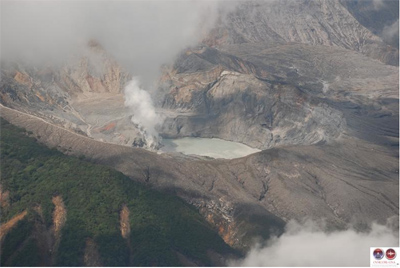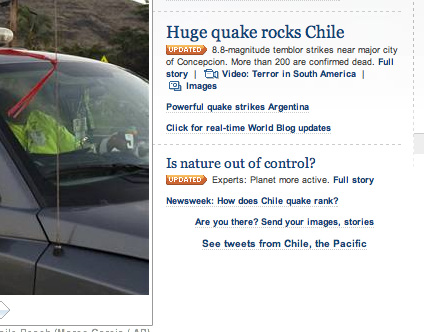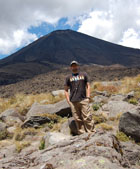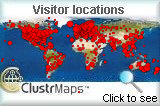March 12, 2010
Category: Kliuchevskoi
Leaving for Death Valley tomorrow - I'll be sure to take some pictures of Ubehebe Crater and the volcano at the Mirage. This will likely be the last new post until about a week from now, but look for the Erta'Ale Volcano Profile, maybe a new Mystery Volcano Photo and I'll leave a thread open for any new volcano news.
Colima in Mexico.
March 10, 2010
Category: Eyjafjallajökull
Did I mention its a busy week?

The lava lake at Erta'Ale in 2008. Image courtesy of Stromboli Online.
March 8, 2010
Category: speculation
Cleaning up some news ... busy week leading up to a field trip I am helping co-lead to Death Valley next week.

Ubehebe Crater in Death Valley, California
March 7, 2010
Category: Baker
Mt. Baker in the northern Cascades of Washington.
One of the best websites dedicated to any volcano is the Mt. Baker Volcano Research Center - hosted by Western Washington University. I've talked about it before, but David Tucker and his associates have put together an excellent resource on this (at least in my opinion) woefully underappreciated Cascade volcano.
There is a pile of news from the MBVRC and I thought I'd pass it along.
First off, the 2010 T-shirt design contest has kicked off. Last year the MBVRC raised much needed funds with a T-shirt sale and now you can try to design the shirt for 2010. The deadline for entries is March 31, so you better get designing.
The MBVRC also posted an image of the Sherman fumarole field taken in early February. Those fumaroles definitely remind you that Baker is one of the most active volcanoes in the Cascades. The image came from John Scurlock, who has some closeups of the fumaroles as well, taken in early March.
Finally, you can follow all the news at the MBVRC over on a new subscription blog started by the Center. Hear all the latest news on Baker and the Center - and it sounds like this summer will be exciting according to Tucker: "There will be some interesting research happening at the volcano this summer- gravimetry, gas sampling, tephra mapping...and the long-awaited USGS Prof Paper on the eruptive history should be out this year, too."
I even forgot that there is a webcam pointed at Mt. Baker from the Ferndale Library, only 30 miles from the volcano ... a nice vantage point when the volcano comes back to life (whenever that is).
Posted by Erik Klemetti at 8:39 PM • 6 Comments • 0 TrackBacks
March 4, 2010
Category: science journalism
As many Eruptions readers read, the headlines produced by MSNBC for their coverage of the recent Chilean earthquake raised my ire. To me, it represented the sensationalism of the events - but as with all things media-related, there is a lot of opinions on the matter.
We were lucky to have Alan Boyle, science editor for MSNBC.com, comment on the fray and he has very kindly offered to take your questions about the coverage of science in the mainstream media. This is a unique opportunity for us to discuss how science is portrayed, the rationale for headlines and generally find out about how the mainstream media tries to give scientific information to the general public. If you have any questions for Mr. Boyle, email me at  . I will select questions to send off to Mr. Boyle and post the answers here on Eruptions.
. I will select questions to send off to Mr. Boyle and post the answers here on Eruptions.
I look forward to getting your questions! (You might even ask Mr. Boyle about how he survived a volcanic eruption.)
Posted by Erik Klemetti at 3:59 PM • 20 Comments • 0 TrackBacks
Category: Eyjafjallajökull

Eyjafjallajökull, an ice-capped volcano in Iceland that last erupted in 1823.
We talked a few weeks ago of signs that there were increasing signs that an eruption could occur on Iceland - increased seismicity on the Reykjanes Ridge suggested that magma might be on the move. Now, we have two pieces of evidence that we might see activity at Eyjafjallajökull, on the southern side of the island nation.
First off, there is a focus of seismicity under the area of Eyjafjallajökull, with an especially large bump in the last 2 days. Both the number and magnitude of the seismicity has been marching upwards, with the latest earthquakes reaching around M3, almost directly underneath the buried (by ice) crater of the volcano. This would suggest that something is up under the ice cap - either magma is moving in the system or the hydrothermal system is experiencing some large fluid flow event. I can't really figure out the depths of these earthquakes based on the Icelandic Met Office page, so any help with that would be greatly appreciated. UPDATE: The depths can be found by clicking the tab above the map marked "table". (Thanks to Bernd for that info.)
Secondly, from what I can gather from a Google Translation of an Icelandic article, there is also signs of inflation at Eyjafjallajökull. The article seems to suggest that the volcano has seen ~40 mm of movement/inflation to the south based on GPS measurements and that the focus of seismicity (when the article was written) was ~10 km below the surface of the volcano. (And any of you Icelandic readers, I'd love to get a better translation!) This would also suggest that magma might be entering the upper echelons of Eyjafjallajökull's magmatic system. UPDATE: It appears that the Icelandic Met Office doesn't think this is leading to an eruption (Thanks to Orri with help on the translation).
Taken together, it looks like Eyjafjallajökull is a prime candidate for the next eruption on Iceland. Eyjafjallajökull (also known as merely Eyjafjöll) is one of a series of volcano systems on the south side of Iceland, near Katla. Amongst the Icelandic volcanoes, it has been relatively quiet, with the last known eruption occurring from 1821 until 1823, with evidence for eruptions in 1612 and 550 AD. The last two eruptions have been VEI 2, with explosive characteristics - and with a volcano under a glacier, we always have the threat of jökulhlaup - glacial outburst flows triggered by the volcanic eruption. And unlike many Icelandic volcanoes, the last eruption of Eyjafjallajökull was produced silicic to intermediate tephra rather than basalt. The larger volcanoes on Iceland such as Eyjafjallajökull, Katla and Krafla have all produced rhyolite eruptions in the dominantly basaltic land - and the rhyolite magma that was hit while drilling last year shows that you can get very silicic magmas even in a hot spot/mid-ocean ridge setting.
{Hat tip to Dr. Boris Behncke and Mattias Larsson for info in this post.}
Posted by Erik Klemetti at 8:41 AM • 457 Comments • 0 TrackBacks
March 2, 2010
Category: Chile
Some news for a busy Tuesday:

The crater at Poas volcano in Costa Rica, taken February 25, 2010. Image courtesy of OVSICORI by Federico Chavarria.
March 1, 2010
Category: Toba
News!

Toba caldera in Indonesia.
February 27, 2010
Category: science journalism

Screen capture of the MSNBC website on February 27, 2010 at ~5:30 PM eastern time.
Most of you have probably already heard about the magnitude 8.8 earthquake that struck today off the coast of Chile. This becomes one of the most powerful earthquakes on record and so far, the death toll has been relatively low - in the hundreds - especially compared to the horrific disaster of the Haiti earthquake from earlier this year. My thoughts go out to all in Chile recovering from the earthquake.
However, I am a little appalled at some of the coverage I've seen for this earthquake. MSNBC has become the vanguard of sensationalist drivel and shoddy science reporting - specifically, the article posted today titled: "Is Nature out of control?" (also seen with the headline "Big quake questions: are they getting worse?") This type of headline is irresponsible, reprehensible "journalism" that the worst hacks should be ashamed to print. I feel like I don't even have to justify it with a response, but honestly, two big earthquakes hours apart in Chile and Japan (or if you want to get bigger, two earthquakes months apart with Chile and Haiti) does not "out of control" make. No geologist would ever even imply this idea - yet somehow MSNBC finds it necessary to use this sensationalist garbage to promote their website. As of Saturday afternoon (2/27), no other major media outlet had such a headline on their front page.
Earthquakes happen, and they happen in a random distribution (more or less), meaning sometimes we get more, sometimes less. Spend any time looking at the USGS earthquake feed and you'll see sometimes we have lots of M3+ earthquakes in a day, sometimes we can go a day or two without really any around the world. More importantly, looking at any of these earthquake patterns in a short timescale (geologically - which means in a human lifetime, maybe two lifetimes) is not sufficient to understand the pattern. MSNBC found one scientist who said that in the last 15 years (relative to the 20 years before that), "the Earth has been more active" - whatever that means - and have blown it up into an armageddon-like story. What does "more active" even mean? Does it mean more total earthquakes? More big earthquakes ? More total seismic energy being released? Does it include volcanoes? What about landslides? Hurricanes? That sort of throwaway line is the sort of thing that feeds the doomsayers and gives science a bad name.
Honestly, I sometimes think I need to go on Cafe Press and get t-shirts made that say "Correlation does not mean causation". Humans perceive connections and patterns in events even when none are there - think about the so-called "Face on Mars". Yes, we've had a number of large earthquakes in the recent past, but have we had a Toba-scale volcanic eruption? Have we had another New Madrid earthquake? The Earth is a big place with a lot of active tectonic margins and even more faults that gather stresses and periodically release them. Sure, they may have some connection broadly speaking, the same goes for the volcano-earthquake connection. However, we have no conclusive proof that these systems are directly related - that is to say, they are not the same as turning your key to start your car engine. Complex systems have many inputs - maybe the volcano that erupts next week would have erupted with a magnitude 4 earthquake, maybe it would have erupted without an earthquake at all. To connect the two merely because they are temporally juxtaposed is not scientifically sound. There is evidence that there could be an effect on nearby volcanism after large earthquakes in some settings, however, it is far from proven.
The point here is that the Earth is an active place - and we have very short experience with seeing events on a global scale. Reckless speculation the likes of which MSNBC (and LiveScience) partook in should be a warning of how the media still has a long way to come when it comes to reporting the facts rather than the hysteria of the natural world.
Posted by Erik Klemetti at 5:29 PM • 122 Comments • 0 TrackBacks










